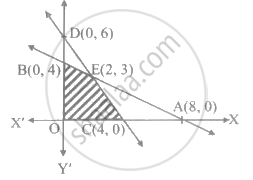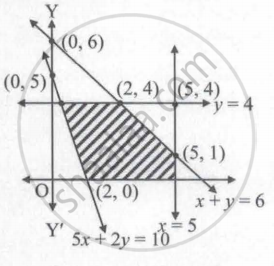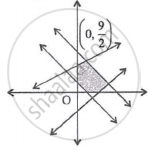Advertisements
Advertisements
Question
Check the ordered points (1, −1), (2, −1) is a solution of 2x + 3y − 6 ≤ 0
Solution
Given inequality: 2x + 3y – 6 ≤ 0
i.e., 2x + 3y ≤ 6 .......(i)
Consider point (1, –1).
Putting x = 1 and y = –1 in equation (i), we get
2(1) + 3(–1) = 2 – 3
= – 1 ≤ 6
which is true.
Consider point (2, –1)
Putting x = 2 and y = –1 in equation (i), we get
2(2) + 3(–1) = 4 – 3
= 1 ≤ 6
which is true.
∴ Given ordered pairs are solutions of 2x + 3y – 6 ≤ 0.
APPEARS IN
RELATED QUESTIONS
Solve graphically: x ≥ 0
Solve graphically : x ≤ 0
Solve graphically : y ≤ 0
Solve graphically : x ≥ 0 and y ≥ 0
Solve graphically: x ≤ 0 and y ≥ 0
Solve graphically : x ≤ 0 and y ≤ 0
Solve graphically : x ≥ 0 and y ≤ 0.
Solve graphically : 2y – 5 ≥ 0
Solve graphically : x +2y ≤ 6
Solve graphically: 3x + 2y ≥ 0
Solve graphically : x – y ≤ 2 and x + 2y ≤ 8
Solve graphically : 2x + y ≥ 5 and x – y ≤ 1
The half plane represented by 4x + 3y >14 contains the point
The value of objective function is maximum under linear constraints
If a corner point of the feasible solutions are (0, 10) (2, 2) (4, 0) (3, 2) then the point of minimum Z = 3x + 2y is
A solution set of the inequality x ≥ 0
Let p and q be the statements:
p: 3x3 + 8y3 ≥ 15, q: 5x + 2y < 11
Then, which of the following is true?
The shaded region is represented by the in equations ______

The maximum value of z = 7x + 6y.
Subject to the constraints x ≤ 45, y ≤ 55 and x ≥ 0, y ≥ 0 is ______.
Region represented by the inequalities x ≥ 0, y ≤ 0 is ______.
Determine the system of linear equation for which the solution set is the shaded region in the following figure ______.
Solution set of the inequality y ≥ 0 is ______.
The set of real x satisfying the inequality `(5 - 2x)/3 ≤ x/6 - 5` is [a, ∞). The value of ‘a’ is ______.
Which of the following linear inequalities satisfy the shaded region of the given figure?

The object function z = 4x1 + 5x2, subject to 2x1 + x2 ≥ 7, 2x1 + 3x2 ≤ 15, x2 ≤ 3, x1, x2 ≥ 0 has minimum value at the point is ______.
The objective function of LPP defined over the convex set attains it optimum value at ______.
